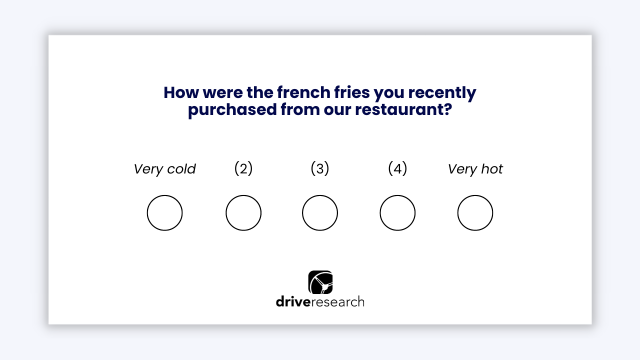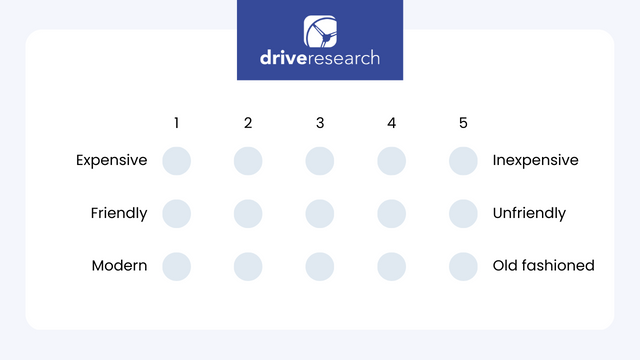Semantic differential scales are a popular type of survey question used in market research to measure attitudes toward a particular concept or object.
This type of scale uses a series of bipolar adjectives or phrases to evaluate the respondent’s perception and evaluation of a concept or object.
In this blog post, our market research company explains what semantic differential scales are, how they work, and provide examples of different types of questions to help you understand how to use them in your research.
Semantic Differential Scale: Definition
A semantic differential scale is a type of survey question that asks respondents to select a specific rating with the two endpoints of each scale being opposites.
It works much like a 1 to 5 or 1 to 10 Likert scale but instead of “1” being least and “10” being most the numbers are replaced with words opposite one another.

An example of a semantic differential scale is a fast food restaurant asking: “How were the french fries you recently purchased from our restaurant?”
As you can see from the picture above, one side of the scale is cold, and the other is hot.
In between each word are radio buttons to allow the participant to lean in one direction or another or select a midpoint.
Semantic Differential Scales vs. Likert Scales
Although the two terms are often used synonymously, semantic differential scales and Likert scale are two different types of rating scales used in research and surveys.
In short, the key difference between the two scales is that semantic differential scales measure attitudes towards an object using a set of bipolar adjectives, while the Likert scales measure the degree of agreement or disagreement with a statement or question.
The differences between semantic differential scales and Likert scales are outlined by our online survey agency in greater detail below.
Semantic Differential Scale:
- Semantic Differential Scale is a rating scale used to measure the attitudes and opinions of respondents toward an object, person, event, or idea.
- It uses a set of bipolar adjectives, such as “good-bad,” “happy-sad,” “strong-weak,” etc., placed at opposite ends of a continuum.
- Respondents are asked to rate the object of interest on each adjective using a 7-point or 10-point scale.
- The scale measures the perceived distance or gap between two opposite concepts, and thus, provides information about the attitude of the respondent towards the object.
Likert Scale:
- Likert Scale is a rating scale used to measure the degree of agreement or disagreement of respondents with a statement or question.
- It consists of a set of statements or questions, and respondents are asked to indicate their level of agreement or disagreement with each statement using a 5-point or 7-point scale.
- The scale measures the intensity of the respondent’s attitude toward a statement or question.
Recommended Reading: 36 Types of Questions from Our Market Research Company
Types of Semantic Differential Scale Questions (with Examples)
As discussed, This type of question uses a series of bipolar adjectives or phrases to evaluate the attitude of a respondent toward a particular concept or object.
Here are some examples of different types of semantic differential scale questions:
- Evaluative Semantic Differential Scale: Measures the overall attitude of a respondent towards a concept or object. Example: Please rate your attitude towards the new product as pleasant or unpleasant.
- Potency Semantic Differential Scale: Measures the perceived strength or power of a concept or object. Example: Please rate the product as strong or weak.
- Activity Semantic Differential Scale: Measures the level of activity associated with a concept or object. Example: Please rate the new exercise program as active or inactive.
- Control Semantic Differential Scale: Measures the level of control that a respondent feels towards a particular concept or object. Example: Please rate the new software as controllable or uncontrollable.
- Arousal Semantic Differential Scale: Measures the level of excitement or arousal associated with a concept or object. Example: Please rate the new movie as exciting or boring.
- Evaluation of Product Attributes Semantic Differential Scale: Measures the perception of different attributes of a product. Example: Please rate the new car on the basis of its comfort level as comfortable or uncomfortable.
What is an Example of a Semantic Differential Scale?
Let’s say you want to better understand your brand. You want to understand associations, image, perceptions, and other affiliations with your company brand and mission.
If you were to create a semantic differential scale around this, it might look something like this, using these words.

The example above details a basic semantic differential scale for brand perception. Sometimes it is helpful to mix up the positives and negatives on each side of the scale.
Final Thoughts
Semantic differential scale survey questions are a powerful tool for measuring attitudes toward various concepts or factors. They allow market research companies, like Drive Research, to collect quantitative or measurable data on the perceptions of respondents on a variety of attributes.
We hope the examples provided in this blog post have helped you understand how to successfully use semantic differential scales in your surveys.
If you’re looking for more help with survey design, programming, fieldwork, and analysis – we can help with that too! Our contact information is listed below.
Contact Our Market Research Company
Drive Research is a national market research firm.
Questions about how our team can assist with your next survey project? Contact us below. We are a full-service market research company that manages projects from start to finish for our clients.



